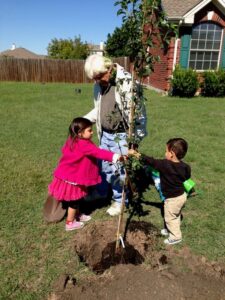
Tanenbaum Peacemaker in Action José “Chencho” Alas, El Salvador
Earth Day reminds us that peace work is planet work. Planet work is peace work.
The impacts of conflict on the planet are widely documented. But what about the positive impact of peace programming on the environment?
One effective strategy encourages people on opposing sides of an issue to band together in a common endeavor: serving as stewards of the environment when it comes to pollution and deforestation. The stakes are universal, as we are all human beings within a complex ecosystem.
We see the value of environmental stewardship across religions and spiritualities. These environmental Shared Visions invite us to learn from our own traditions and value others.
In his peace work, Peacemaker in Action José “Chencho” Alas of El Salvador connects to his faith tradition with the environment, animating the concepts stated above. Below is an excerpt from Chencho’s Mother Earth, Our Common Home reflection:
“After 15 years of living in exile, from 1977-1992, I returned to my country, El Salvador, with a heart full of joy to contribute to the recovery of my land that had been devastated by war from 1980-1992. As a result of the war, I found that my country had plunged into greater poverty. Hundreds of thousands of people were forced to emigrate from their places of origin, either internally or externally, to neighboring countries, the United States, Canada, or Europe.
I returned to Suchitoto, my last parish, and it was very hard for me to witness that 70% of the population of the countryside and the city had emigrated. The people who lived in Suchitoto were no longer the same, they were new, and the majestic hill of Guazapa looked bare of vegetation, it had been sprayed with white phosphorus imported from the United States and Israel. The hill served as a stronghold for the guerrillas during the war.
I asked Mario López, former guerrilla commander, what my contribution could be to the reconstruction of the human network. Mario requested that I collaborate in the Lower Lempa River where 47 rural communities had been established. I received financial support from the Kellogg Foundation. They donated $300,000. The contribution served to organize families in groups of 7 to 10 for food production, introducing organic farming. The families understood the importance of being organized.
We founded the Coordinating Committee of the Communities of Bajo Lempa and together we created a peace program. This was the beginning of the Local Peace Zone following the UNESCO model. I facilitated a total of 36 peace workshops and we obtained the participation of 114 communities. The crime was lowered to zero and in 1998 we declared the region a zone of peace after having been one of the most violent in the country.
Very soon we discovered that the area needed a reforestation program, especially the coast of Jiquilisco Bay. We began receiving delegations of Jewish university students sent by American Jewish World Service, based in New York, and with them we planted hundreds of thousands of mangrove candles* on the beaches. Mangrove, like coral, serves as a nest for shrimp and fish multiplication.
It is clear that wars only serve to destroy our Mother Earth and burden our populations with poverty.
The war industry only serves to enrich a very small number of wealthy people feeding on the blood of the poor. The only thing that can save us from violence is solidarity of the peoples, a universal recognition that we have been created in the likeness of God and that our dignity is above any material means.”
*The mangrove produces seeds that are like candles. It doesn’t multiply by the roots. You plant the candles.
As Peacemaker José “Chencho” Alas teaches us, the wellbeing of the planet and people are closely intertwined. Let this Earth Day be a reminder of the greater impact we can make when we choose to work together to protect our shared planet.